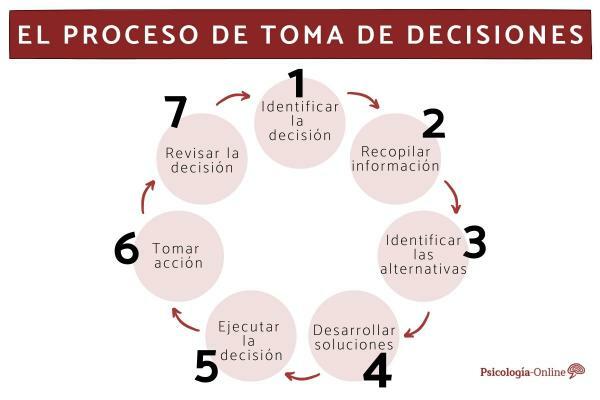
What strategies do groups adopt when making a decision? Are two heads always better than one? Is the union always strength? With this Psychology-Online article we will try to understand together the steps of the decision-making process, how groups decide and why, sometimes, they intensify or cancel the differences between their members. We will see the phases of the decision-making process, the theories and the mechanisms involved according to various authors, with personal and business examples
Index
- What is decision making
- The decision-making phases
- Phases of group decision-making
- Time pressure
- Group polarization
- Groupthink
What is decision making.
What is the decision-making process? The decision making consists in choose one option from several possibilities to resolve a situation. Making decisions is essential in all areas of life (personal, work, family, business ...).
The moment of decision-making is very important in the life of a group, and can lead to an alteration of its dynamics internal: when the group must make a decision, it can call into question the balance previously achieved, causing a crisis, but it can also represent the occasion when individual components carry out dynamic expulsions or the integration of others.
When the group makes a decision, the individual components focus their attention on the objective aspects of the problem, thus activating predominantly cognitive and manifest thought processes about the structural aspects of the group; Less evident, on the other hand, is the fact that at the time of the decision there are also variables of a subjective nature linked to the procedural aspects of the group.
The phases of decision making.
The literature offers a number of new contributions to Decision-making process: simple theoretical models that cover all the steps needed to guide participants in the decision, and what we will take into consideration - because among the most recognized by experts - consists of three phases articulated in seven steps: identification phase (recognition of opportunities, problems and crises, collection of relevant information and clearer identification of the problems), development phase (alternative solutions to problems are generated and modified) and selection phase (alternative solutions are generated and modified to problems).
1. Identify the decision
The first step in decision making is to identify the problem, and to make a decision, you have to identify the problem you want to solve, taking into account the critical or strategic factors that define it, since they hinder a solution adequate.
2. Collect relevant information
Once your decision has been identified, it is time to collect all the relevant information for that election.
3. Identify the alternatives
With the pertinent information at hand, you identify possible solutions to your problem, as there is usually more than one option to consider when trying to achieve a goal.
4. Develop alternative solutions
The main objective is to make the best possible decision among the available alternative lines of action, finding creative or original solutions.
5. Execute the decision
Once you have collected all the relevant information, developed and considered the possible paths to follow, you are perfectly ready to choose. After ranking the options, you must choose the one you consider to have the best chance of reaching your goal; In some cases, you can combine multiple options, but in most cases, there will be a clear direction you want to take.
6. To take action
Once you've made your decision, act on it, and develop a plan to make your decision tangible and achievable.
7. Review the decision
The last and important step in the decision-making process is to evaluate the effectiveness of your decision, since monitoring allows you to identify its deficiencies or negative consequences, providing valuable feedback on which the decision can be reviewed or reconsidered.
The decisions that an individual makes every day are the result of a process to solve problems, small or large, which are called "heuristics": a decision-making process that does not use all the logical-analytical pathways described above, but takes advantage of "shortcuts" relying on the so-called "intuition" when evaluating the variables and information at their disposal and adapting the decisions to the circumstances of time and place. In addition, the decision-making modalities depend on the type of task that you must face.
Phases of group decision-making.
On the other hand the decision-making process in groups de Forsyth (1990) usually has four phases:
- Orientation phase: includes the identification by the group of the task it intends to carry out, the objective it intends to achieve and the strategies you must use to achieve it (in most cases, the type of objective determines the choice of strategies).
- Discussion phase: the team searches for information, identifies possible solutions and assesses; The attempts to influence the members of the group on the others are very present in this phase, as well as in the next one regarding the real decision making.
- Decision phase: In the decision-making process, the group refers to some rules, implicit or explicit.
- Application phase: the group acts accordingly and evaluates its effectiveness.
However, decision-making requires that other factors be taken into account in addition to the group's communication network: among these, for For example, time pressure, the degree of cohesion of the group, the power effectively in the hands of the leader and his style of leadership of the group same.
The temporary pressure.
Some authors have shown that when a group must make a decision pressed for time, regardless of the type of task, uses heuristics (simple and efficient rules for complex problems or incomplete information) and activates social processes of influence normative.
Group polarization.
It is difficult for everyone to have the same opinion: there will always be a majority of people who think of one way, that he proposes to act along a certain line, and other people who will think otherwise way. When the discussion of a group succeeds in generating a commitment, the position reflected in the final norm of the group is more moderate than the initial opinions of its individual members and produces an effect called depolarization. Instead, when the initial intermediate position of a group shifts to a more extreme position after discussion among group members, the process of group polarization occurs. However, this phenomenon cannot be generalized to any type of group, since it does not work for groups in which people do not know each other or do not have a leader, but it can occur in those in which there is a relational exchange consolidated.
Groupthink.
The polarization process can lead to a more consistent and certainly more cognitive bias in the decision-making process. harmful: Through his studies on decision-making, social psychologist Irving Janis concluded that a often groups are more concerned with reaching consensus than with making the right decision, a phenomenon he calledgroupthink or groupthink.
In 1961, President Kennedy and his advisers attempted to overthrow the government of Fidel Castro by invading Cuba with 1,400 CIA-trained Cubans in exile. The Bay of Pigs invasion was a true failure, due to the lack of study of the Cuban territory and its defensive lines: when Kennedy planned The invasion could count on a compact group of advisers, but the critical information was not considered, but gave their consent to the faithful of President.
Here is a theoretical analysis of groupthink (Janis and Mann, 1977):
Social conditions
- High cohesion
- Isolation from the group
- Lack of methodological research and evaluation procedures
- Management leadership
- High stress and low degree of hope in the search for a better solution than the one preferred by the leader or other people considered influential
Search for consensus: symptoms of groupthink
- Overestimation of the group: illusion of invulnerability; belief in the intrinsic morality of the group
- Narrow-mindedness: collective rationalization; stereotypes of outside groups
- Pressures for uniformity: self-censorship; illusion of unanimity; direct pressure on dissidents; self-surveillance
Consequences of a flawed decision-making process
- Incomplete analysis of alternatives
- Incomplete analysis of objectives
- Failure in risk analysis in relation to the preferred option
- Insufficient information search
- Selective bias in the rapid processing of information
- Failure to reconsider alternatives
- Failure to prepare mandatory projects
These symptoms not only lead to wrong decisions, but also disastrous and dire, and to counteract this process is It is necessary to understand what is the motive and the cause of groupthink: to each of the causes mentioned corresponds an attitude to fight them. Avoid group isolation, foster a critical mindset, actively encourage dissent, minimize the intervention of the leader, encourage self-criticism without fear of express doubts and objections, are scientifically proven strategies to reduce and counteract thinking group.
This article is merely informative, in Psychology-Online we do not have the power to make a diagnosis or recommend a treatment. We invite you to go to a psychologist to treat your particular case.
If you want to read more articles similar to The 7 steps of the decision-making process, we recommend that you enter our category of Personal growth and self-help.
Bibliography
- Forsyth, D. R. (1990). Group dynamics. Belmont: Wadsworth Cengage Learning.
- Janis, I. L., Mann, L. (1977). Decision making: A psychological analysis of conflict, choice, and commitment.Free Press.
- Karau, S. J., Kelly, J. R. (1992). The effects of time scarcity and time abundance on group performance quality and interaction process. Journal of Experimental Social Psychology, 28(6), 542–571
- Leone, G., Mazzara, B. M., Sarrica, M. (2013). Social psychology. Processi mentali, communication and culture. Rome: Laterza.
- Moscovici, S., Zavalloni, M. (1969). The group as a polarizer of attitudes. Journal of Personality and Social Psychology, 12(2), 125–135.
- Myers, D. G. (1983). Social Psychology. New York: McGraw-Hill.
- Panpatte, S., Takale, V. D. (2019). To study the decision making process in an organization for its effectiveness. The International Journal of Business Management and Technology, 3(1):2581-3889.
- Scialoja, P. (et al.) (1998). Psicologia sociale delle organizzazioni. Naples: Alfredo Giunta Editore.


